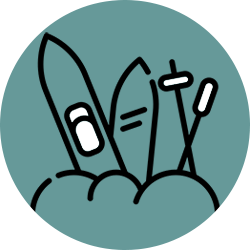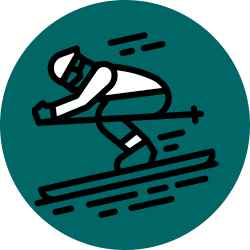Injuries from winter sports and activities: Snowboarding
You’re reading our Data Blog, a great way of getting quick facts and the latest data on different public health topics.
- Last updated: 2024-01-16

Winter in Canada provides favourable weather conditions for outdoor sports and recreational activities, including skiing, snowboarding, ice skating and sledding. While there are numerous health benefits resulting from these sports and activities, there are also risks of serious injuries.reference1-3 These risks highlight the importance of personal safety, such as wearing appropriate clothing and safety equipment, and ensuring your gear is in good condition. For more information on winter safety tips, please visit the following sites:
This data blog presents injury statistics on popular winter sports and activities captured in the Canadian Hospitals Injury Reporting and Prevention Program (CHIRPP) between October 1, 2016 and January 11, 2024. CHIRPP is a sentinel surveillance system capturing injuries and poisonings presenting in 20 emergency departments across Canada. Every year, approximately 170,000 injury and poisoning records are entered in the database, from which information on the circumstances, types and emergency department outcomes of injuries can be examined. In this data blog, records with injuries related to sledding/tobogganing, ice skating, alpine skiing and snowboarding were examined.
Alpine skiing:

Overall
Between October 1, 2016 and January 11, 2024 there were 5,434 alpine skiing-related injuries reported in the CHIRPP database, representing 690.5 cases per 100,000 CHIRPP records. Of these injuries, the average age among patients was 16.9 years and males represented the largest percentage at 57.8%. Among children, those aged 5 to 9 years represented 43.3% of all cases (Table 1). Among those injured, 66.7% (n = 3,622) stated that they were wearing safety equipment when the injury occurred.reference1
Table 1. Demographic characteristics of alpine skiing-related cases in CHIRPP, October 1, 2016 to January 11, 2024.
| Characteristics | Count | Proportion (%) | |
|---|---|---|---|
| Sex | Male | 3,157 | 58.1 |
| Female | 2,277 | 41.9 | |
| Age group (years) | 2 to 4 | 157 | 2.9 |
| 5 to 9 | 1,111 | 20.5 | |
| 10 to 14 | 2,350 | 43.3 | |
| 15 to 19 | 984 | 18.1 | |
| 20 to 29 | 229 | 4.2 | |
| 30 to 39 | 117 | 2.2 | |
| 40 to 49 | 148 | 2.7 | |
| 50 + | 327 | 6.0 | |
Note: 11 reported cases were missing information on age.

Type of injury
Shown below in Table 2 are the types of injuries resulting from the reported alpine skiing-related injuries. Representing over a third of all injuries and the largest percentage (39.4%) were fractures. Soft tissue injuries (17.2%) and dislocations/sprains /strains/pulled elbows (14.5%) were the second and third most common types of injuries reported, respectively. Table 3 provides a breakdown of the body regions where the fractures occurred. Of the 2,139 reported fractures, the upper and lower extremity regions were similar in terms of distribution. With respect to the upper extremity region, wrist fractures were most common, whereas lower leg fractures were more common in the lower extremity region.
Table 2. Type of injury from alpine skiing-related cases in CHIRPP, October 1, 2016 to January 11, 2024.
| Type of injury | Count | Proportion (%) | |
|---|---|---|---|
| Fractures | 2,139 | 39.4 | |
| Soft tissue injury | 935 | 17.2 | |
| Dislocation/Sprain/Strain/Pulled elbow | 788 | 14.5 | |
| Traumatic brain injuries | All traumatic brain injuries | 759 | 14.0 |
| Concussion | 546 | - | |
| Minor head injury | 191 | - | |
| Intracranial injury | 22 | - | |
| Superficial/Open wound | 342 | 6.3 | |
| Injury to nerve/vessel/tendon | 225 | 4.1 | |
| Injury to internal organ | 37 | 0.7 | |
| Other | 105 | 2.0 | |
| Not specified | 100 | 1.8 | |
Table 3. Fractures by body regions among alpine skiing-related cases in CHIRPP, October 1, 2016 to January 11, 2024
| Body region | Body part | Count | Proportion (%) |
|---|---|---|---|
| Upper extremities | All upper extemities fractures | 861 | 40.3 |
| Wrist | 241 | - | |
| Finger or thumb | 204 | - | |
| Forearm | 186 | - | |
| Upper arm | 88 | - | |
| Elbow | 73 | - | |
| Hand | 69 | - | |
| Lower extremities | All lower extremities fractures | 851 | 39.8 |
| Lower leg | 503 | - | |
| Knee | 118 | - | |
| Thigh | 112 | - | |
| Ankle | 72 | - | |
| Hip | 24 | - | |
| Foot | 21 | - | |
| Toe | 1 | - | |
| Trunk | All trunk fractures | 377 | 17.6 |
| Clavicle | 247 | - | |
| Shoulder | 48 | - | |
| Thorax | 31 | - | |
| Thoracic and lumbar spine | 29 | - | |
| Pelvis | 18 | - | |
| Sacrum and Coccyx | 3 | - | |
| Spine (not specified) | 1 | - | |
| Head and Neck | All head and neck fractures | 50 | 2.3 |
| Face | 39 | - | |
| Cervical spine | 7 | - | |
| Head | 4 | - |

Event circumstances associated with fractures
Table 4 shows the event circumstances associated with the reported fractures. A 30% random sample of all fractures (n = 642) showed that falls represented the highest percentage of cases at 67.0%. Following this category, the second and third most common circumstances were fractures involving jumps (12.6%) and individuals coming into contact with stationary objects/structures, such as trees, rocks and chair lift poles (8.9%).
Table 4. Event circumstances associated with fractures from alpine skiing-related cases in CHIRPP, October 1, 2016 to January 11, 2024.
| Mechanism | Count | Proportion (%) |
|---|---|---|
| Fell while skiing | 430 | 67.0 |
| Fracture occurred as a result of a jump | 81 | 12.6 |
| Hit stationary object/structure while skiing | 57 | 8.9 |
| Came into contact with person | 35 | 5.5 |
| Injury involving mechanical chair lift | 12 | 1.9 |
| Not specified | 27 | 4.2 |

Emergency department outcomes
Table 5 presents a breakdown of the emergency department outcomes of the reported alpine skiing-related injuries. Of the 5,434 records, the majority of patients required treatments in the emergency departments (58.4%). There were 404 reported hospital admissions, and of these, 74.8% were associated with fractures and 7.5%, with injuries to internal organs.
Table 5. Emergency department outcomes – alpine skiing-related cases in CHIRPP, October 1, 2016 to January 11, 2024.
| Emergency department outcomes | Count | Proportion (%) |
|---|---|---|
| Treatment required at emergency department | 3,170 | 58.4 |
| Left without being seen by physician or advice only provided | 1,431 | 26.4 |
| Observation in emergency department | 424 | 7.8 |
| Admitted to hospital | 404 | 7.4 |
| Death | 1 | 0.02 |
Note: Four reported cases were missing information on the emergency department outcome.
- Date modified: